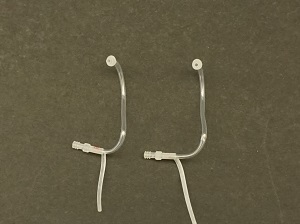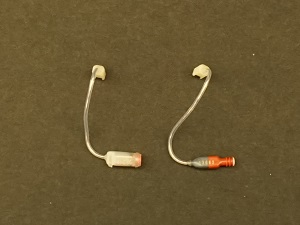Question
What can you do when the patient says the hearing instrument is making their ears itch?
Answer
The ear canal has very delicate skin; even a hair may cause itching in the ear. So no wonder itching or irritation is a common complaint from the hearing aid user who comes in for a follow up visit. Madsen, Larsen and Flink (1991) showed 39% of earmold users experienced itching as a side effect. In many cases, users become accustomed to it and the itching sensation will pass, but there are instances that can be due to other factors and need our attention. These could include such issues as poor fit or allergic reaction to otoplastic materials.
Open Fittings
The domes for open fitting are made from medical grade silicone; allergic reaction is less likely than for a custom earmold. However, some patients can be allergic to the cleaning agent used to clean the dome. Chlorohexadin, a commonly used disinfectant in the clinic, is an example of such an agent.
One of the most common causes of itching for open fitting is poor fit of the dome in the ear canal. Whether it is a thin tube or receiver-in-the-ear (RIE) style, we are dealing with non-customized fitting and limited tube/receiver lengths and dome sizes to select. It follows that the fit cannot be perfect in all cases. When patients do complain about itching/irritation with an open fitting, we need to have a look at the fit. Is the tube too short, pulling the skin of ear too tight, or is it too long, causing the hearing aid to “float” above the ear? A too short tube will cause pressure to the skin; a too loose tube may cause the hearing aid to move easily and cause irritation when the head is moved. Is the dome size right? Try to change the dome size or change to a different type of dome (open dome, tulip dome or closed dome). Is the dome insertion in the canal too deep or too shallow? Figure 1 shows a pair of thin tubes where the length of the vertical part is about the same, but the horizontal part of the left thin tube is shorter than the right one. This means the right one will go into the ear canal a little deeper. For RIE devices, if the audiogram falls in the fitting range of more than one power level of receivers, one receiver choice may provide a better fit than the other. For example, the two receivers shown in Figure 2, both from the same manufacturer and for the same hearing aid, have similar gain and output characteristics. However, the receivers are quite different physically and may feel quite different to the individual patient when worn. If the physical fit is good, but the patient still complains about irritation, applying a bit of lubricatant (such as Eargene or Otoease) to the dome may help. Finally, a customized earmold can also solve issues with itching, especially if the itching is caused by the dome not remaining in a stable position in the ear canal.

Figure 1: size 2B (left) vs. size 2A (right) thin tube; the horizontal part is shorter with size 2B thin tube

Figure 2: size 3 medium power receiver (left) vs. size 3 low power receiver (right). The low power receiver is thinner but slightly longer. Although there is a large overlap in the fitting ranges for each receiver, one or the other may provide a better fit for the individual.
Closed Fittings
For closed fittings with custom earmolds/shells, itching or irritation can be due to poor fit, allergy to the otoplastic materials, moisture in the ear or wax accumulation. Have a look at the ear and ask the patient which part is causing the itching. Patients can often guide us to find the irritation site. Check if there is wax accumulation in the ear canal, or any localized redness or swelling. If there is not localized redness, try using something like a cotton swab to touch the ear to find the irritation site. Also check the earmold to see if there is moisture in the sound tube. When there is perspiration in the ear canal, the moisture trapped between the earmold and ear canal will cause an itching sensation. The extra moisture also encourages the growth of bacteria and/or fungus which can exacerbate the issue beyond a subjective itching sensation.
Poor fit is also a common cause of itching. In Madsen and colleagues' (1991) research, no objective changes were observed in 38% of the itching ears; in cases where objective changes did occur, these changes were often limited. When there is visible change, the patient should try to avoid wearing the devices until the changes are completely cleared up. If there is an identifiable protrusion on the earmold/shell that seems to be the cause, an obvious solution is buff the area down. If the offending area is not obvious or it is not possible to buff out, mark the point that causes the irritation and send the earmold to the manufacture for a remake. If the new earmold/shell still causes a problem, it is time to take a new ear impression, perhaps using a different technique (open jaw vs. closed jaw).
Allergy to earmold materials is less common than fit issues but it does happen, especially for earmolds made from acrylic or epoxy resin. Several acrylics, including polyethylene glycol dimethacrylate, 2-hydroxyethyl methacrylate, methyl methacrylate, triethyleneglycol dimethacrylate, and urethane dimethacrylate have been reported to cause contact dermatitis in the ear (Marshall, Guill & Odom, 1978; Sood & Taylor, 2004; Meding & Ringdahl, 1992). The allergic reaction is often caused by incomplete cure of the monomers. Heating the earmold by boiling it in saline will increase polymerization and reduce the amount of residual monomer, thus alleviating the problem. Having the earmold made from silicone can solve most cases of allergic reaction. Another effective option is to have the earmold gold-plated. If dermatitis does not resolve after the patient has discontinued wearing the hearing aid, referral to a dermatologist is recommended.
Moisture in the ear can be tricky. In order to get rid of the moisture, the vent needs to be large, but for more severe hearing losses, the vent needs to be small to prevent feedback. It is important for patients to schedule regular visits to get their ears cleaned if they have a history of moisture-related issues or wax. Extra wax in the ear will trap more moisture and it takes longer to dry the ear. Hearing aids should be cleaned and put in a hearing aid dryer during the night.
Apart from the causes discussed, dry skin can cause itching for both open and closed fittings. Dry skin tends to peel or crack and is extremely sensitive to irritation; scratching will further damage the skin and make the itching worse. Alcohol should not be used to clean the ear if the skin is dry as this will also make matters worse. A few drops of olive oil may help keep the ear from getting too dry and also protect it from water. However, do not put oil in the ear if the patient wears RIE or custom aids as this may cause damage to the receiver. Commercial products like Eargene, Otoease and Miracell can also be used to soothe the skin.
Summary
Itching due to wearing hearing aids is common, but it can be treated or alleviated. Make sure the patient gets the best fit; keep both ears and hearing aids clean and dry; use lubricant or moisturizer if needed, switch to non-allergenic material if an allergic reaction occurs, and refer to an ENT or dermatologist when necessary.
References
Madesn, E.F., Larsen, J., & Flink, P.O. (1991). Itching in the external ear - a side effect of ear plugs. Ugeskr Laeger, 153, 2125-8.
Marshall, M., Guill, A., & Odom, R.B. (1978). Hearing aid dermatitis. Arch Dermatol, 114(7), 1050-1.
Meding, B., & Ringdahl, A. (1992). Allergic contact dermatitis from the earmolds of hearing aids. Ear Hear, 13(2), 122-4.
Sood, A., & Taylor, J.S. (2004). Allergic contact dermatitis from hearing aid materials. Dermatitis,15(1), 48-50.

